Joachim Löw’s Germany hosted Michael O’Neill’s Northern Ireland for the final match of the Euro 2020 Qualifiers in group C. Germany had already secured qualification into the tournament, but the 2014 World Cup champions were seeking the win which would see them retain first place. For Northern Ireland, a play-off place was already confirmed before the match.
Because of this, Northern Ireland were pressure-free, able to attempt tactical tweaks and aim to spoil the party for the hosts. The Northern Ireland players and fans may have also been following the guidance of O’Neill for the final time, given his recent appointment as the manager of Stoke City.
The match finished 6-1 to the hosts. This tactical analysis will investigate how Germany were able to convincingly beat Northern Ireland via an investigation into the tactics of both teams. Specifically, the analysis will include information on offensive, defensive and transitional components of play from each team, as well as other key match events.
Line-Ups
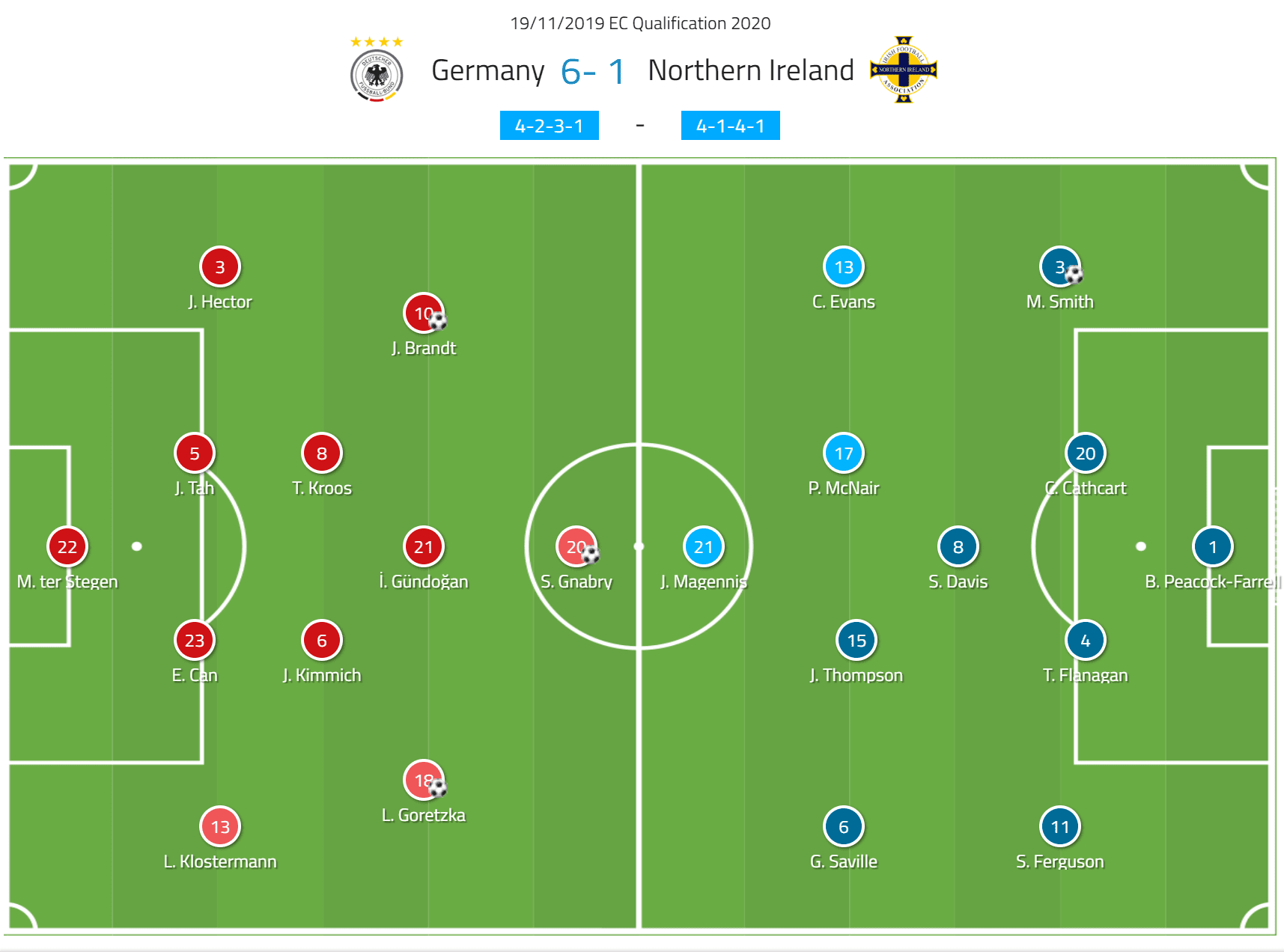
By taking a brief look at the line-ups, we can see that, on paper, Germany operated in a 4-2-3-1 formation whereas Northern Ireland used a 4-1-4-1. Of course, formations and team shape fluctuate within performances as players from both teams interact, this will be discussed in the next section.
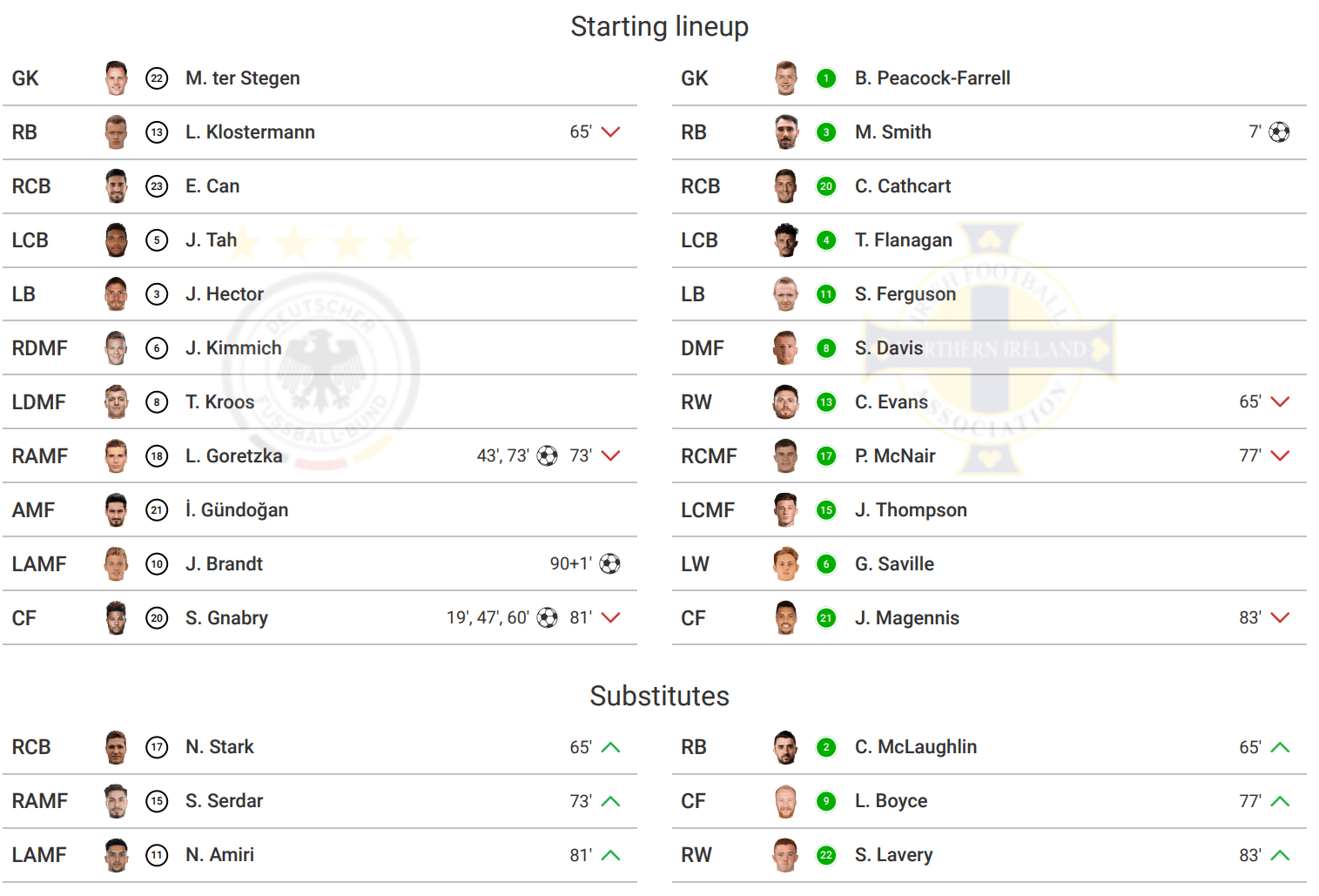
In terms of personnel, Germany utilised their strength in depth and rotated numerous players when compared to previous qualifiers, using such depth to try and determine their best starting eleven come Euro 2020. The interesting choice by Löw was to play the in-form Serge Gnabry upfront, rather than a more recognised striker in Timo Werner. The move paid off as Gnabry backed up his recent Champions League hat-trick with a hat-trick in the 6-1 demolition of the visitors. For Northern Ireland, O’Neill picked many of the players trusted throughout the qualifying campaign, given their smaller pool of international level players, but also due to their performances which has seen the Northern Irish players once again perform above expectation to secure a playoff spot.
Average formations
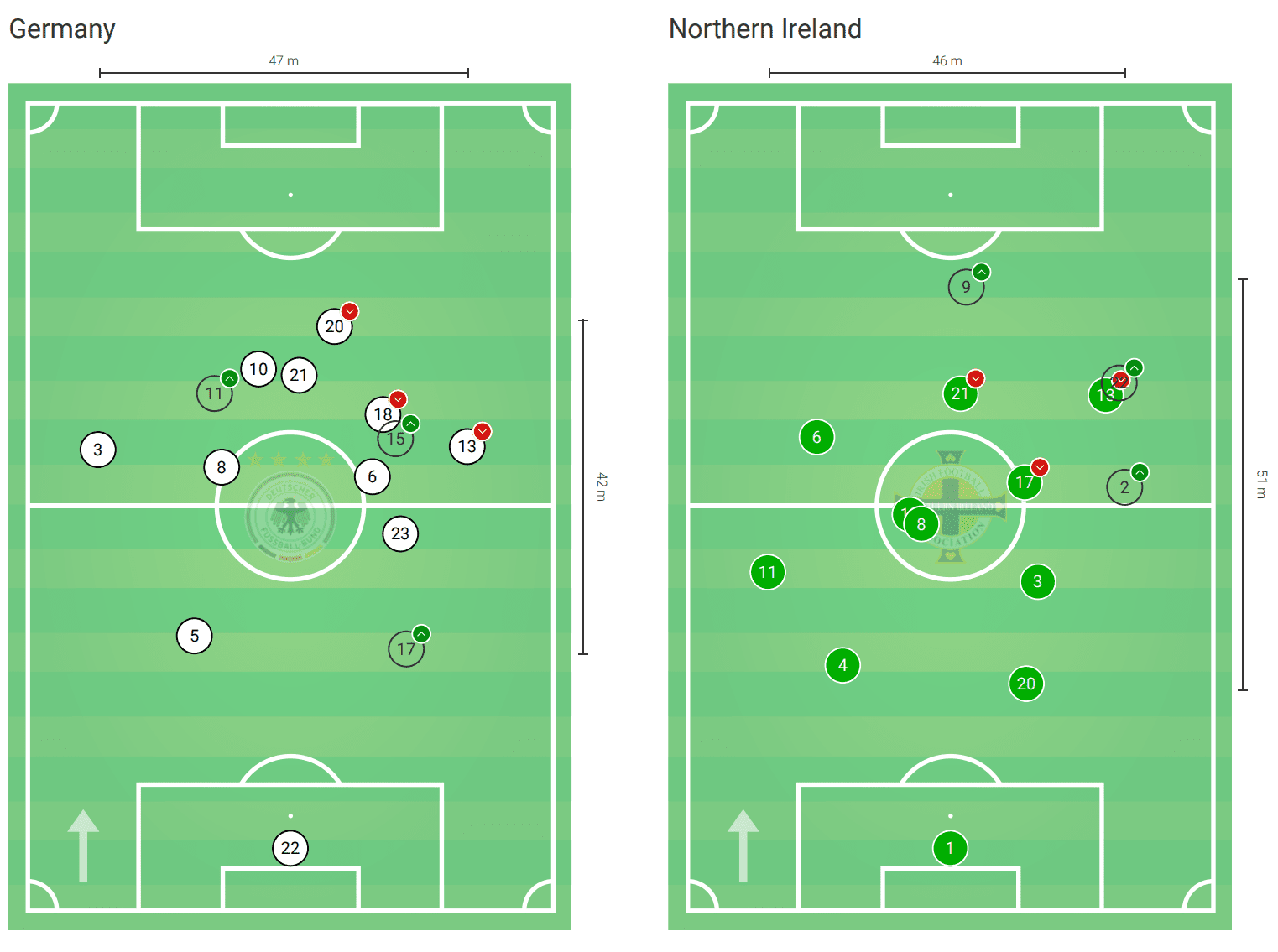
As stated, formations on paper do not always translate into average positions and formations. From the graphic, we can see that Germany, with their match dominance, essentially played a 2-4-4 formation if players were defined into three units. Northern Ireland appeared to play a 4-3-3, which differs from the 4-1-4-1 stated as the wingers push up into the attacking line whilst the three central midfielders play closely and rotate where needed.
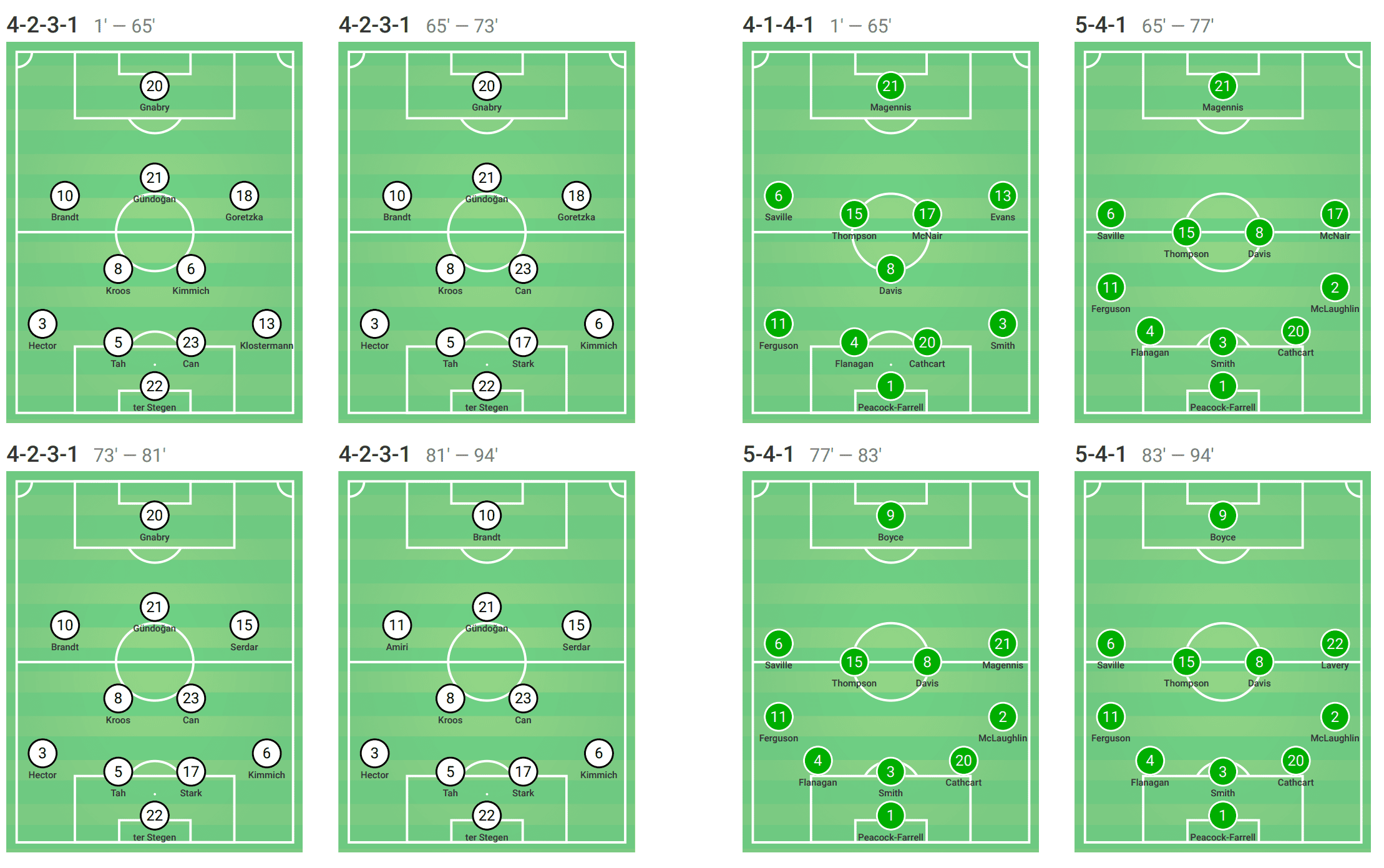
If we take a look at the key formation changes during match periods, Germany’s successful system stayed the same, whilst Northern Ireland switch to a 5-4-1, which explains, the original right-back, Michael Smith’s inverted average position marker, given he was moved to centre-back during the match, seemingly to add more defensive security.
Match stats
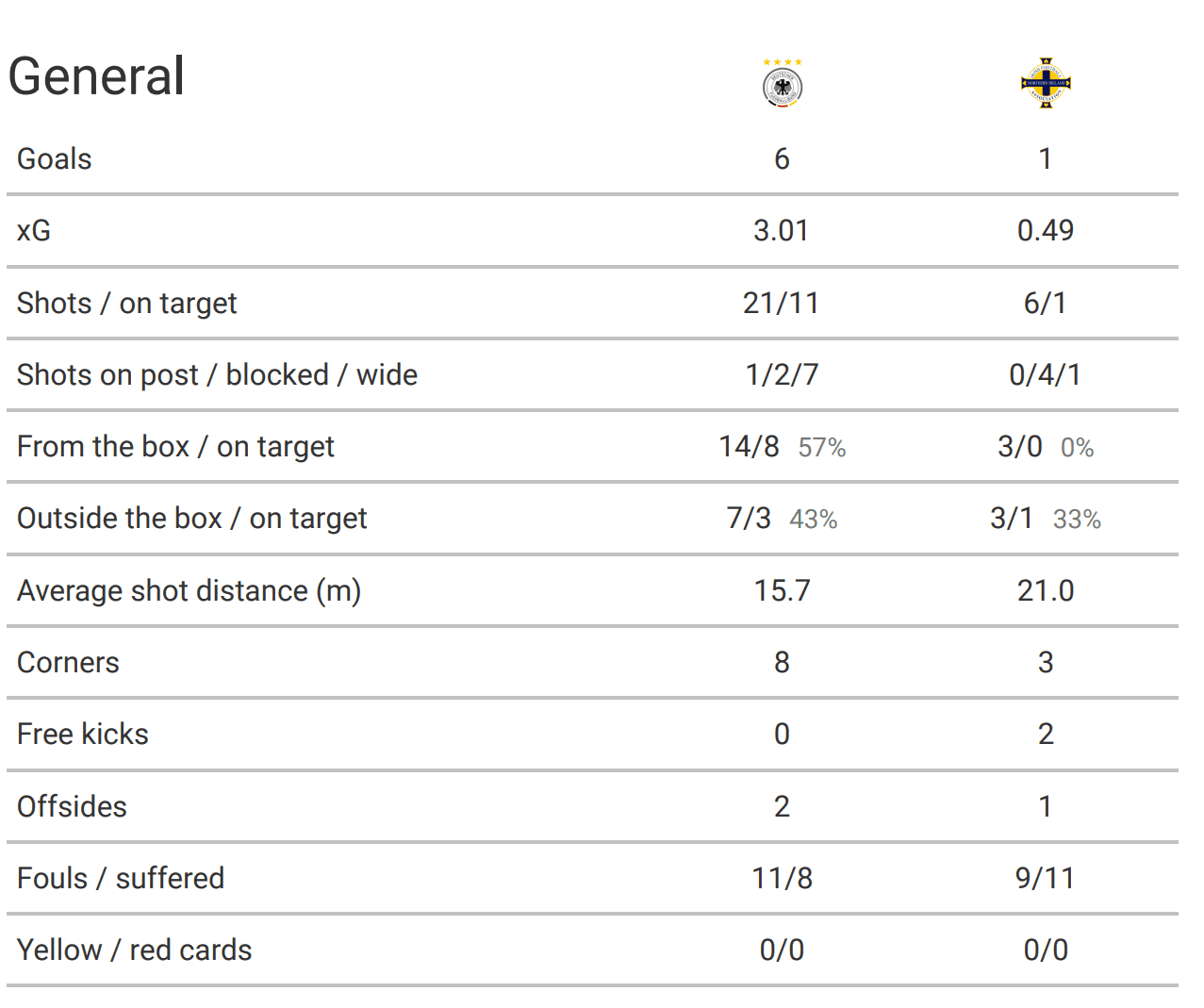
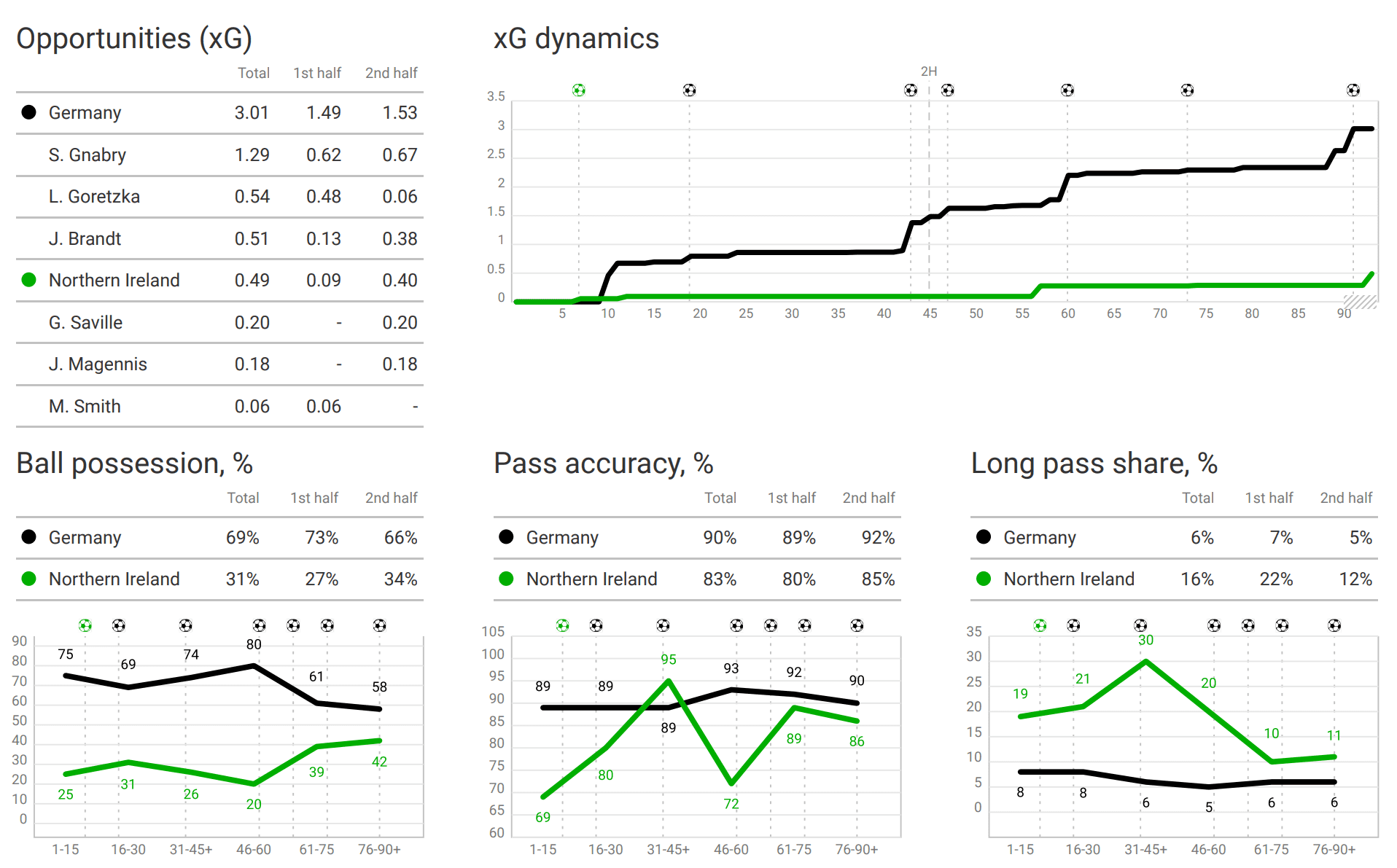
As expected given the score gap, Germany dominated the game in performance stats and output. The 2014 World Cup winners created higher quality chances than Northern Ireland with an xG of three but finished at a rate above that of an average player by scoring six goals. Northern Ireland did not create any ‘big chances’ and scored their solitary goal via an impressive finish from Smith. Due to the location of the shot, with that number of players between him and the goal, the position of the goalkeeper and other XG variables, the model predicts that only six per cent or six out of one hundred of those shots would result in a goal.
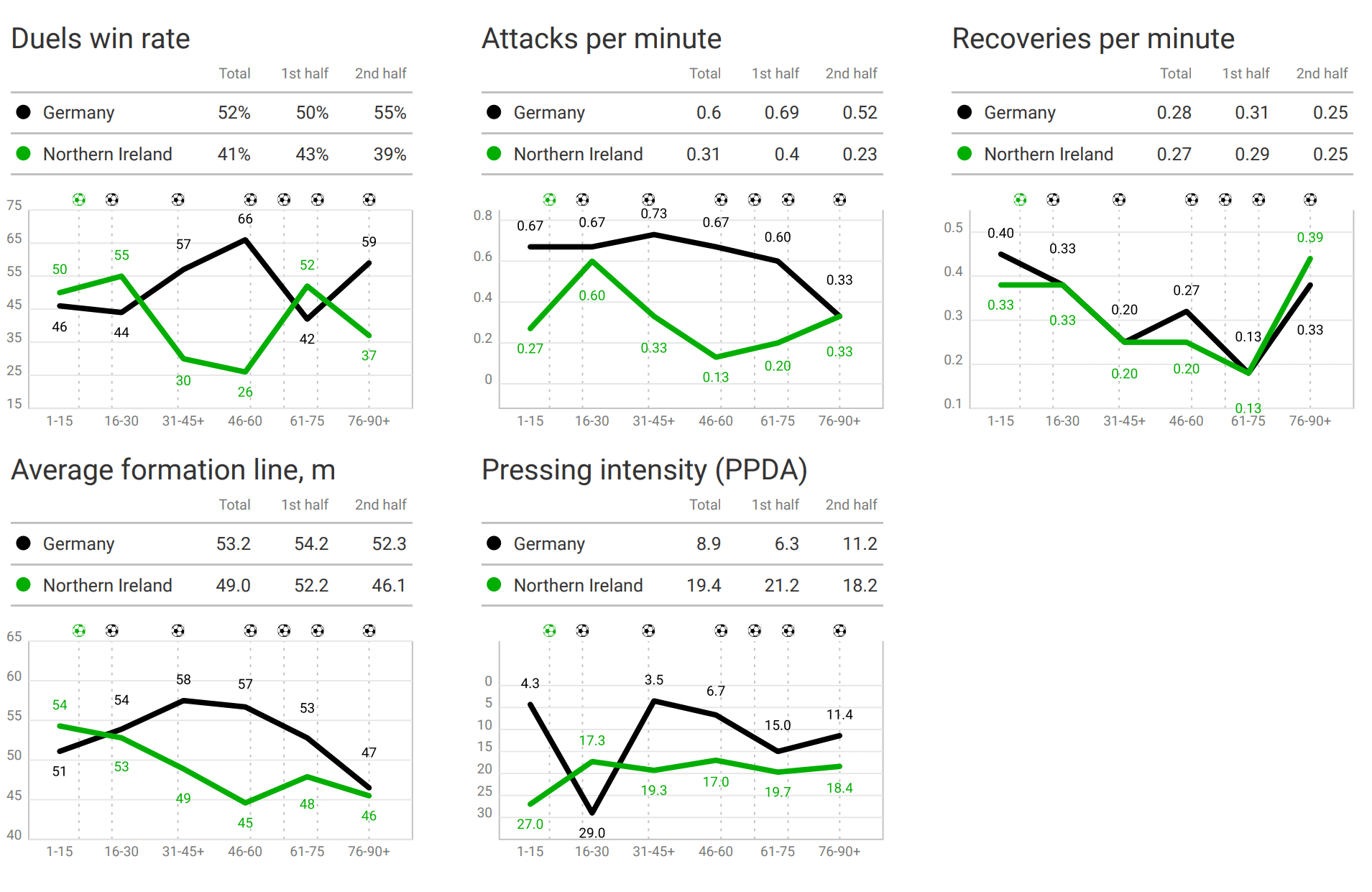
Germany also excelled in possession, passing accuracy, duels, attacks per minute, ball recoveries and pressing intensity. Again, reinforcing their superiority in multiple game phases. From the long pass percentage, we can identify that Germany prioritised a short-passing approach in order to breakdown Northern Ireland in possession, where Northern Ireland utilised a more direct approach to try and hurt Germany quickly when they won the ball back, or to provide some respite via a long pass or clearance.
Passing networks
A comparison of the passing network reinforces Germany’s ball domination, with many passes played between teammates via interaction. Northern Ireland’s pass map highlights a low number of pass interactions between teammates due to a lack of possession and the intent to attack quickly when the ball was won.
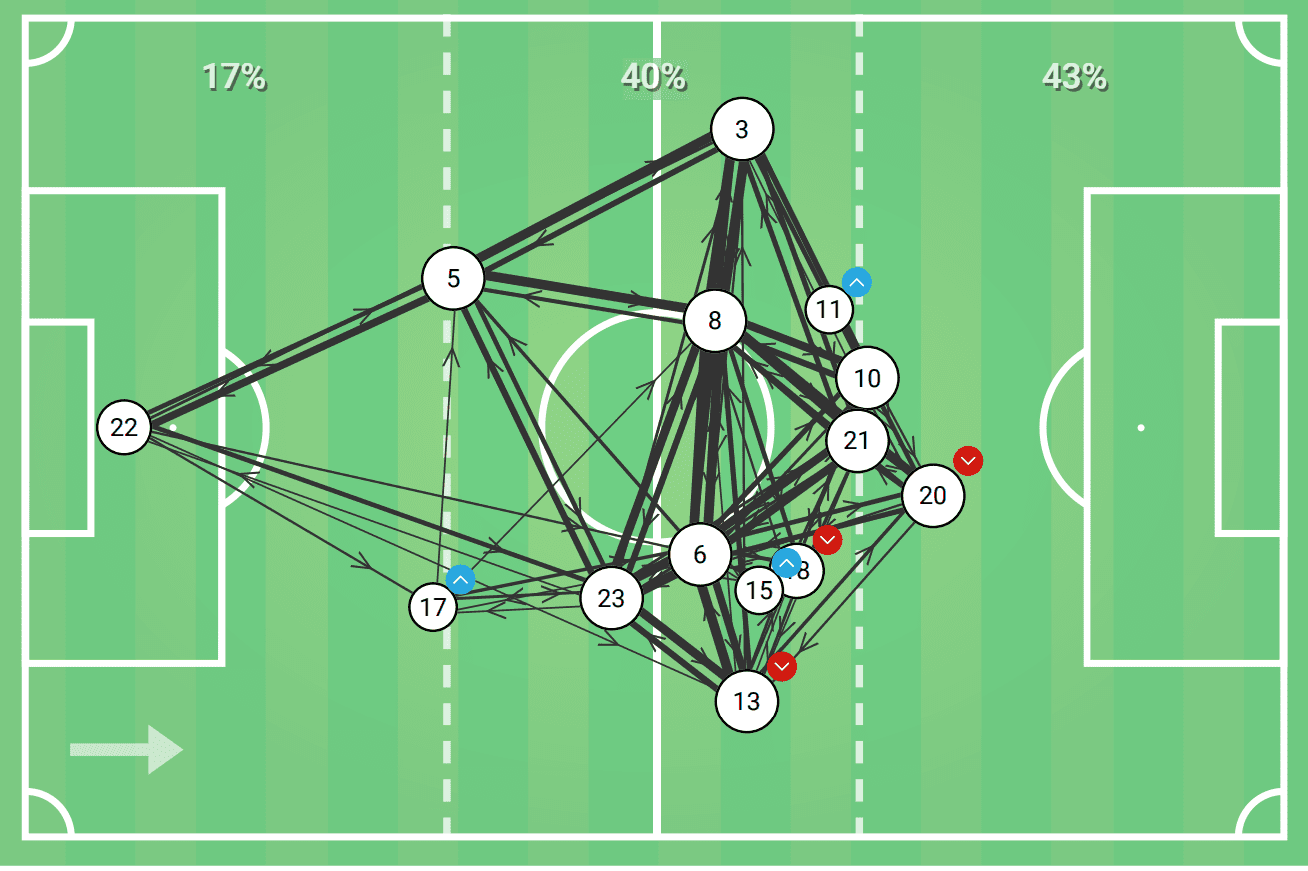
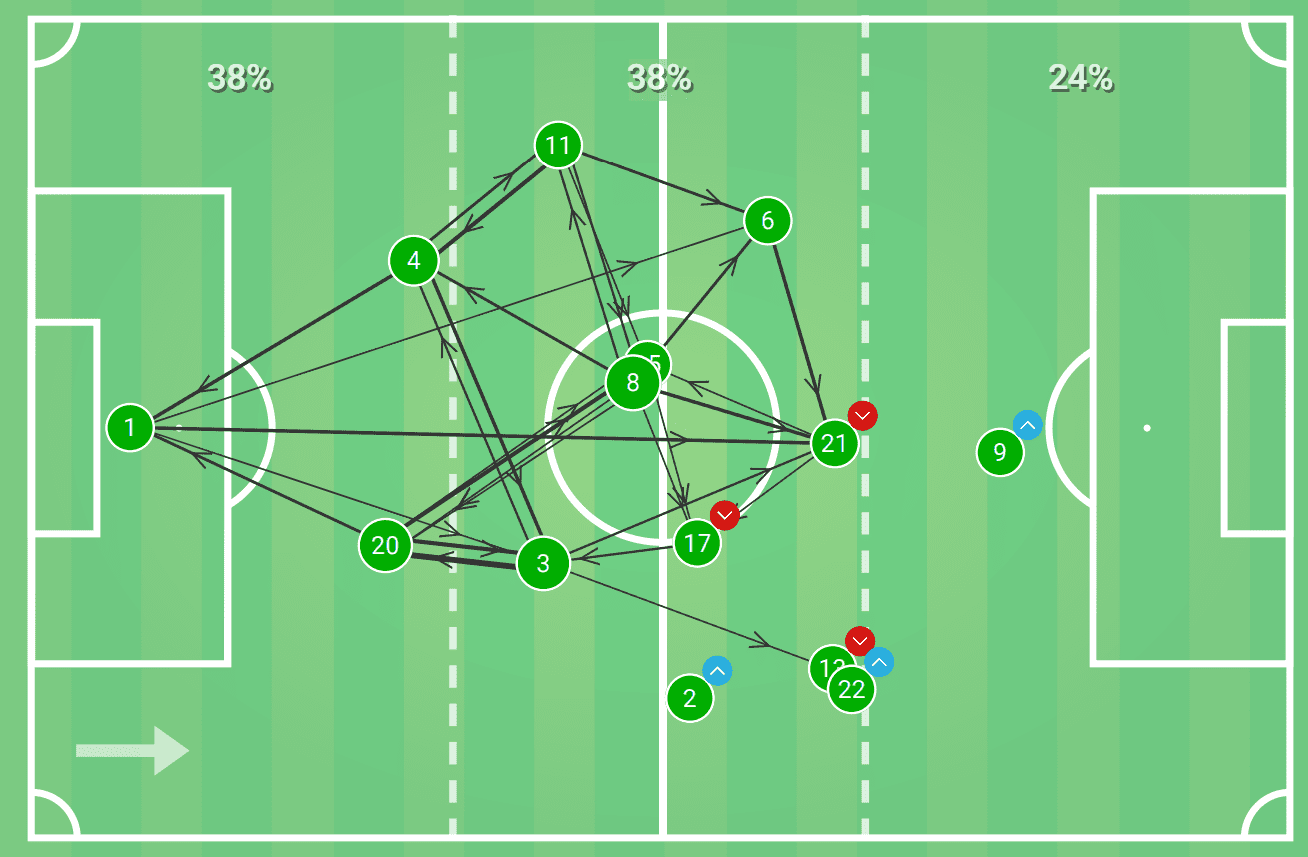
Germany’s patient play
Due to the quality of Germany’s players on the ball, Germany were patient in possession and were happy to pass and move in order to try and manipulate the Northern Ireland defence. Germany organised their players and passed around the Northern Ireland players in a U shape, biding their time and waiting for the moment to play the ball into the box.
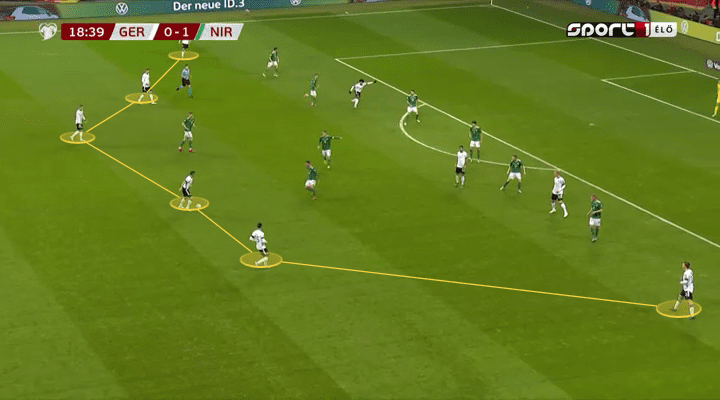
This style of play was not just adopted because of Germany’s values, but because of the narrow shape of Northern Ireland. In order to try and limit the distances between players in each defensive line of players, the Northern Ireland lines played narrow. This allowed space for Germany’s full-backs to push on high and wide. The full-backs were frequently in space to receive the ball and cross, or to recycle at the end and start of the U possession movement.
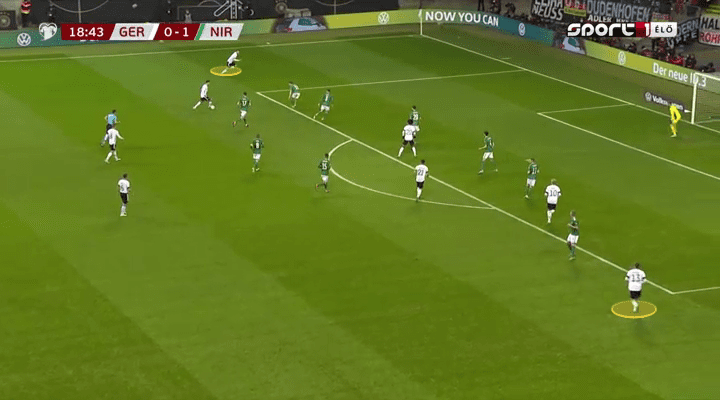
This tactical complexity was added to further by the positioning and rotation of Germany’s main attackers. Germany had four players within the width of the Northern Ireland defence attempting to find space to get on the ball between the defensive and midfield line. Such players positioning caused Northern Ireland to mark narrow, resulting in the extra space for the full-backs as discussed. The positioning of the four attackers and two full-backs for Germany allowed the two centre backs and two central midfielders to sit deeper and dictate the play within the U shape.

Northern Ireland should have restricted the spaces between their defensive and midfield line in order to limit the space the Germany attackers had to receive the ball in. But, that was not the main issue for Northern Ireland. What made defending even harder was the rotation of the four attacking players mentioned. If the players did not find success between the lines, they moved out of their position to get involved in the play or become a passing option. This left the Northern Ireland defenders with a marking dilemma as their designated man had left their zone. The smart play from the Germany attackers was to wait for the ball to go wide due to the lack of space against the narrowed defence and then make late runs into the box. The late runs meant that defenders who were focussed on the cross from the high and wide full-back did not see the arriving threat for the Germany attacker who had floated away from their zone initially. This left Germany players unmarked and created numerous opportunities.
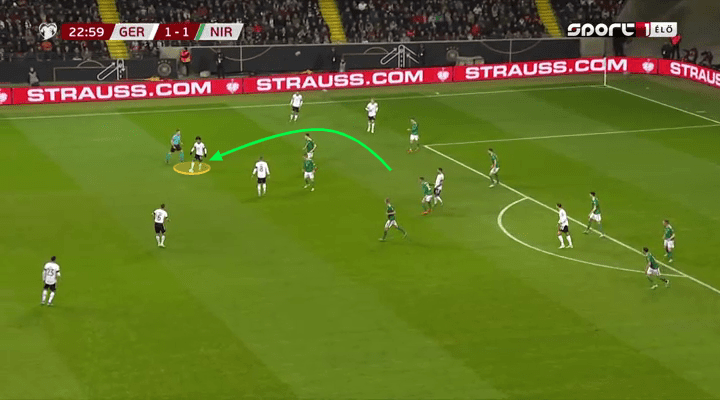
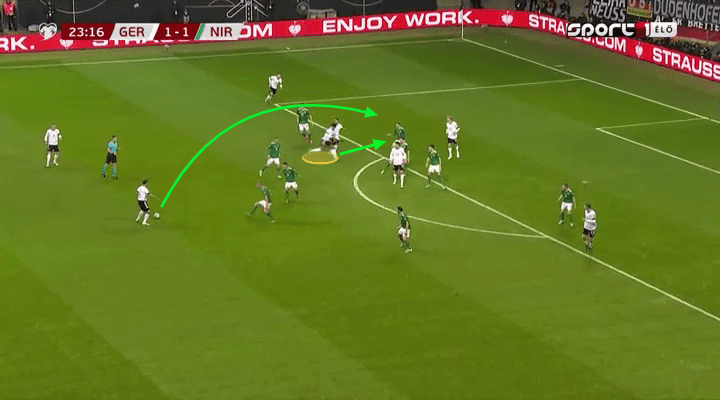
Northern Ireland struggle to gain a foothold
Due to the shape and pitch coverage of Germany, Northern Ireland rarely had the chance to transition into a counter-attack or sustained attack. The majority of attacks could be characterised as transitional or counter attacks due to the short nature of such attacks.
The Northern Ireland players looked to play up to Josh Magennis as the sole target unless the wingers had a chance to press up the flanks. The balls into such players were direct in order to try and capitalise on the space left by the Germany full-backs. If a direct attack could not be achieved, the Northern Ireland players tried to gain pitch coverage down the flank via throw-ins or by earning set pieces for which they could utilise their two or three aerial threats from defence.
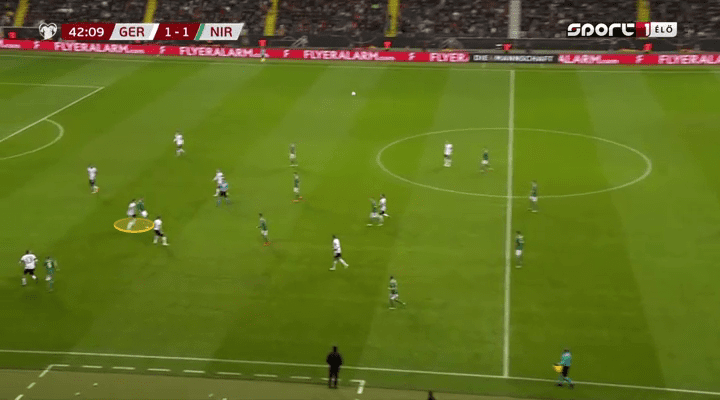
In a defensive transitional sense, Northern Ireland’s press was poor, frequently consisting of one player which allowed Germany to easily play out or through the Irish lines. Whilst the press wasn’t used intensely in favour of maintaining defensive shape, the lack of pressure on the ball once Northern Ireland had dropped into shape allowed Germany to play their U pattern with relative ease. The issues were extended when Ireland were slow to drop into shape after a poor press.
Germany regain and repeat
After the short possession sequences that Northern Ireland experience, Germany transitioned from defence to attack in a controlled, relaxed manner, choosing to retain possession and build up from there. This was exaggerated due to the team being numerous goals ahead. But, Germany retained their playing values when winning the ball back, unless there was a specific offensive player they could find in space or to run at the Irish defence.
When transitioning from attack to defence. The positions players took up when in possession and attacking set the team up well for losing possession. The four players who played deepest covered the sole Northern Ireland striker, offering a large numerical superiority, should additional opposition players enter their defensive zone. In addition, the players in more advanced positions were close to the deep and narrow Irish block and therefore an intense press was possible. Should Northern Ireland advance into the German half, it usually involved few attacking numbers. In these situations, the German units retreated before the deeper players pressed from one side while the recovering offensive players surrounded the player from the other.
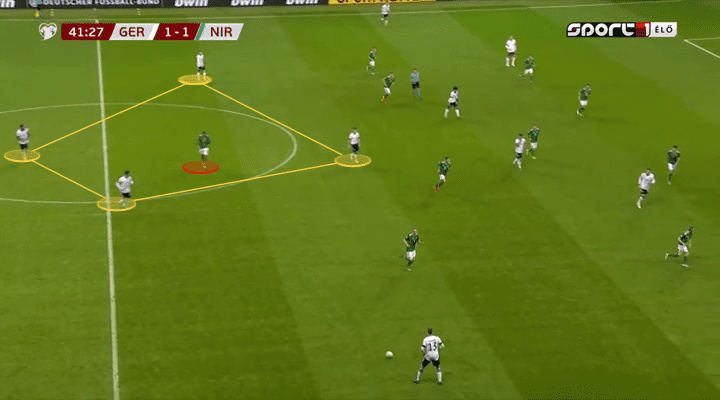
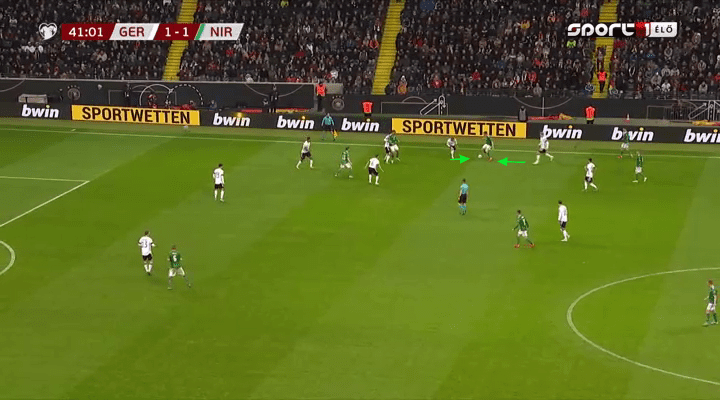
Set Pieces
Regarding set pieces, there were no majorly inventive routines. For Germany, they executed short corners in order to maintain their possession sequence and U passing pattern.
For Northern Ireland, they relied on accurate delivery from corners, wide or deep free-kicks in order to find one of the numerous aerial threats via Magennis or one of three central defenders. Unfortunately for the visitors, such delivery combined with effective attacking or ineffective defending was not achieved.
Conclusion
Overall, Northern Ireland took the lead through a fantastic strike from outside the box. After which, it appeared that Northern Ireland might achieve another big scalp to add to other impressive performances from O’Neill’s reign. However, that strike was the only notable attacking threat from the visitors. Thereafter, Löw’s Germany took control of the game, dominating possession, pinning the Irish defence back and utilising effective width, rotations and structure to break the opposing defence and create numerous chances to win the game. Germany are going to Euro 2020 in good form, whilst Northern Ireland will need to win their playoff match to join their group C counterparts.

If you love tactical analysis, then you’ll love the digital magazines from totalfootballanalysis.com – a guaranteed 100+ pages of pure tactical analysis covering topics from the Premier League, Serie A, La Liga, Bundesliga and many, many more. Buy your copy of the November issue for just ₤4.99 here






Comments